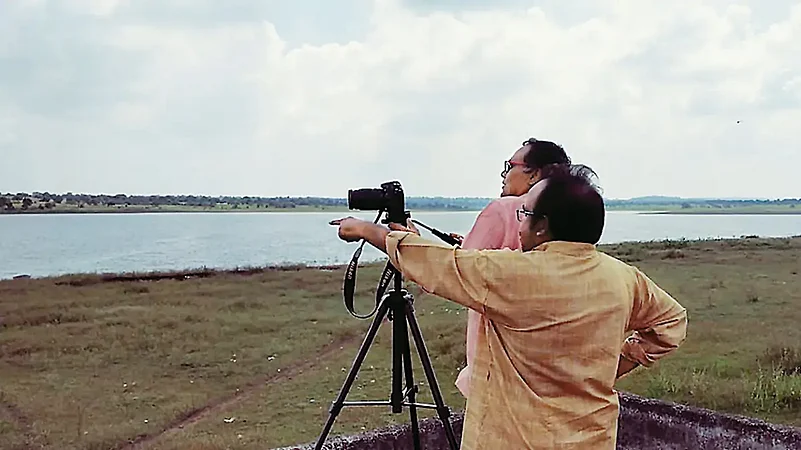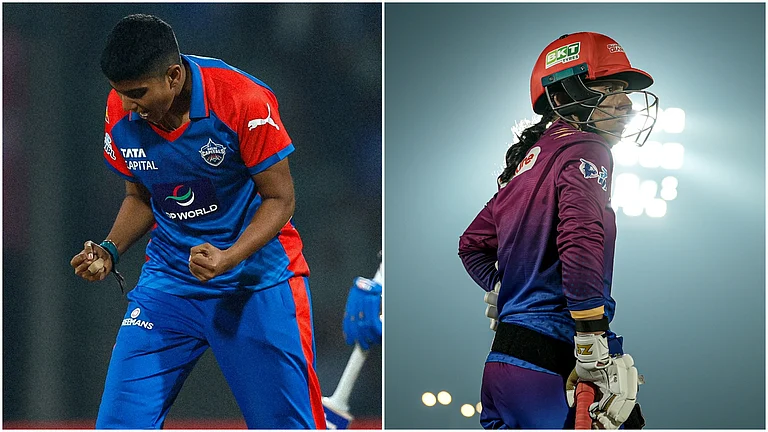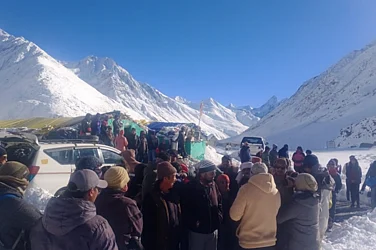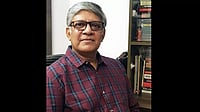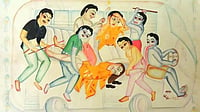Kothagudem-based Adilaxmi matches her mechanic husband’s skills in repairing tubes and tyres of two/three/four wheelers, trucks, earth movers and tippers. There’s Komera Jaazi, an Ayurvedic practitioner who cultivates sorghum on a one-acre field as manna meant for sparrows that are fast becoming extinct since cell phone towers cropped up in this corner of Andhra. Locals in Chintoor, East Godavari District, swear by a medicinal oil with secret ingredients that delays greying of hair.
These and other similar vignettes—of attempts at agrarian inventions or pure jugaad from Andhra Pradesh and Telangana’s hinterlands—are raking up likes and comments after getting featured as vlogs on Rural Media, a YouTube channel by award-winning journalist Shyam Mohan. Before this, the 55-year-old Hyderabadi was a cartoonist whose illustrations featured in international journals Entwicklungspolitik and Wendekreis, followed by stints at the edit desk of two mainstream Telugu newspapers. But in 2009, he quit legacy media after multiple instances of his tribal and rural stories getting “hacked mercilessly” and used as “fillers”, or even “killed” at the editing table. “I had so many leads on exclusive stories on problems experienced by farmers, Dalits and tribals, which were never given a proper response by the management.”

Mohan began doing freelance projects, reports, documentaries and case studies for grassroots’ agencies and NGOs, for which he had to travel to remote areas and interact with tribals. Still dissatisfied by their representation in mainstream media, he launched ruralmedia.in in 2015. However, freelance gigs ate into his resolve to consistently create and upload videos, till the pandemic hit and all assignments dried up. In these two Covid-riddled years, he focused single-mindedly on Rural Media, and used the time to edit old footage and shoot new videos. “I visited over 120 tribal villages in Telangana and Andhra that have no electricity or schools, potable water, medical facilities, roads, etc. People there have no clue what a Rs 500 note looks like. These are places where no media has ever gone.” Today, the channel has 224 video uploads with a subscriber-base nearing the 25k mark, and some videos crossing 3 lakh views.
Not only is the sizeable population of Dalits, Gotte Koya and Gondu tribes in Bhadra Kothagudem and Adilabad districts wary of outsiders, the terrain they live in is inaccessible and tricky. However, his years of forging connections with NGOs working in these areas has smoothened his travels. “Tribal villages do not have proper roads. Even after travelling for 2-3 hours from my home by car, I might have to continue another 4-5 km on foot to reach a village. In the rains, sometimes waist-deep canals have to be crossed. The food is different. In forests of Bhadrachalam, tribes folk eat steamed rice with ants. And they don’t trust newcomers from the city. So we would stay with them for 2-3 days, share meals, ask them about their lives to build trust. Gradually, they would open up and provide us insights into their lives.”

Mohan’s interest in farming methods stems from fond memories of his childhood, spent in a village working alongside his mother in her paddy field. “Farmers have the power to cultivate any type of soil. The government must buy their crops at a minimum price and on time, and design policies that aid the cultivation of rare, indigenous crops and forest produce for new, valueadded products, thereby increasing employment opportunities. For instance, tribals in East Godavari District make mahua oil, which is a great remedy for knee pain. My vlog on this, currently being edited, shows the making process. The people making this oil make very little profit, and could do with a little government backing.”

ALSO READ: Love: Man, Women And A Viral Story
Depending on the need, he either hires a cameraman for Rs 5K a day, or a Nikon D500 or Sony Alpha a7 camera, or just records videos on his Samsung Galaxy S21 mobile phone. For videos that don’t need much editing, he turns to KineMaster, a mobile app, but for footage that is lengthy or has too much background noise, he avails of professional editing services that range between Rs 1-3K. The video is then edited, subtitles added and finally uploaded; a process that takes 1-2 weeks in total. His daughter Poornima, a B.Tech, and son Nirmal, who is in college, help with editing videos in their spare time. “On days my father is not in the field, he sits in front of the computer from 7am, when he wakes up, till 11pm, his bed time—editing, writing, researching on these rural issues and achievements… I’m very proud of him,” says Poornima.
Care is taken to keep the focus on the protagonist(s) and their story, and so Mohan makes a rare appearance only when it is unavoidable. All videos are in Telugu with Telugu subtitles, barring a few with English subtitles. However, Mohan “is already working” to make English subtitles for existing and new videos, after many viewers—including Telugu parents wanting to share these videos with their children who cannot comprehend their mother tongue—requested for these. Given the popularity of the channel, viewers often write to Mohan nowadays, providing him with leads. Monetary returns are little, but showing signs of improvement. Rural Media generates Rs 15k onwards in monthly revenue for ads shown within the videos. It is why he continues to take up research projects for NGOs and does special feature stories for Andhra Jyothi, TALRadio, BBC Telugu and other regional media houses, which goes towards paying for the rented equipment or other services. Occasionally, his projects coincide with the work of NGOs, and travel expenses get reimbursed. His wife Malathi, a private tutor for Math, helps to supplement home expenses.

Things are looking up. In 2017, he received the Rythu Nestham award for best rural journalist from Vice President M Venkaiah Naidu. After watching a Rural Media video on lack of roads in the tribal Peddakonda village in Rampachodavaram, an Integrated Tribal Development Agency project officer stepped up to help. In response to another video, showing a dearth of facilities in tribal villages near Bhadrachalam, the Telangana State Human Rights Commission issued a notice to the government. Netizens are lauding him in the comments section for recent videos on farm labourers in Bazarhatnoor of Adilabad district, who devised ‘motorbike-plough’—a free-of-cost solution for weeding land; and on a self-watering plant box, made by a Rahul from Hyderabad, which needs refilling just once a month.
One of his upcoming videos is about a carpenter in Andhra who builds teakwood treadmills that run without electricity—costing between Rs 15-20k—less than half of comparable models in the market. He is also working on a “problem-solving measure” to teach tribal youth how to edit videos, “…so they can start their own YouTube channels and be their own voice”. “Rural Media focuses not only on problems of tribals and Dalits, but also on their progress and productivity in using local resources. This vlog is my goal to make the government and the world listen to those who do not know how to write or speak in the language of power,” says Mohan.
(This appeared in the print edition as "Arcadian Voice")
ALSO READ






